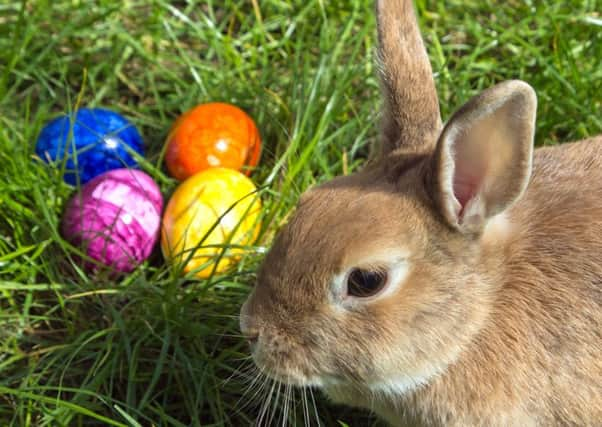SHORT STORY FOR THE WEEKEND: The Easter Bunny, by Debbie Kocziban
This article contains affiliate links. We may earn a small commission on items purchased through this article, but that does not affect our editorial judgement.


Easter festivities are summoned as a gateway to reflect and celebrate one of the most important events of the Christian calendar – the death and resurrection of Jesus.
There are many symbols representing important elements of the Passion – hot-cross buns, simnel cake, palm crosses, chocolate eggs, all absorbed into our culture representing the tradition of the season.
Most of this I can make sense of, but the Easter Bunny?
Advertisement
Hide AdAdvertisement
Hide AdI haven’t heard a Christmas carol mentioning a rabbit flip flopping around the manger alongside the cattle, sheep and donkeys.
There is no biblical reference to Moses or Isaiah slaying bunnies as sacrifice, no allusion to a Skippy the Kangaroo-type cottontail seeking out the disciples and thumping morse-style messages of impending doom, waggling his pom-pom tail in the general direction that the rescue party should follow.
Anyone who has observed rabbits would also know their lack of potential as bearers of chocolate confectionary – particularly delicately fashioned items.
Hopping along on all fours, as they do, any beautifully crafted items would be completely trashed by the time it reached the intended recipient. Maybe only specially designated bunnies are chosen for the task.
Advertisement
Hide AdAdvertisement
Hide AdThose with the strongest, springiest haunches who can bounce along on their two back legs pass the Rabbit Ninja test and are awarded the honour of the Order of the Easter Bunny.
So how did these furry little cuties become synonymous with the Pasquale celebrations?
Well, in common with the majority of Christian festival, the Easter Bunny does not have a biblical bibliography but has its roots in the world of paganism.
The word Easter was borrowed by the Early Christian church as a derivative from the name of Oestra, goddess of fertility and growth, who represents spring and the resurrection of nature which has laid dormant during the winter months.
Advertisement
Hide AdAdvertisement
Hide AdOestra wasn’t averse to performing a few miracles herself. Legend has it that she found a wounded dove in the forest, and attempted to heal it.
Well, it might go against the grain of received wisdom, but Oestra must have been having an off day because, much to its surprise, the bird took on the external body of a rabbit.
Not wishing to appear churlish or ungrateful the rabbit-bird laid eggs for the goddess as a token of thanks. She was so prolific that the goddess could not use them all and hid them as a game for children to find.
The merging of the Christian and Pagan seems to have come about in Germany in the early 1500s with the appearance of eggs, which diversified into manufactured representations of eggs in the 16th century that could be filled with gifts.
Advertisement
Hide AdAdvertisement
Hide AdLater in the 19th century, more stylised versions appeared made from pastry and the first chocolate versions appeared.These were delivered, not by a bunny but a hare.
18th century German settlers introduced the custom to the States where children made nest-like hats in which the Osterhaus lay brightly coloured eggs – echoes of Oestra’s grateful patient.
This marrying of the two belief systems – eggs symbolising resurrection for Christians and fertility, encompasses the idea of death and rebirth which is also encapsulated by the ending of the barren season of winter into the fecundity of spring.
By the 19th century the hare had metamorphasised into a bunny, maybe in response to the introduction of the rabbit as a pet and a object of familiarity – it is certainly cuter and more easily tamed than the rambunctious energetic hare.
Advertisement
Hide AdAdvertisement
Hide AdWhatever the reasons for the emergence of the tradition, children everywhere are only too happy to celebrate and stuff their faces and tummies with the Easter Bunny’s offerings and maybe somewhere Oestra and Jesus are fondly watching, happy that rebirth and new life are still celebrated as the wheel of the year turns...
Send your short story to the Portsmouth Writers’ Hub via e-mail at [email protected]. For more information check out the Portsmouth Writers’ Hub on Facebook.